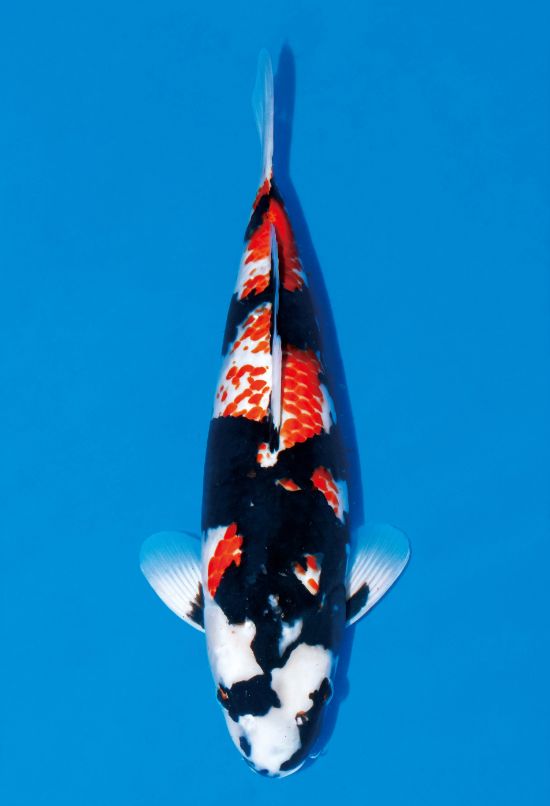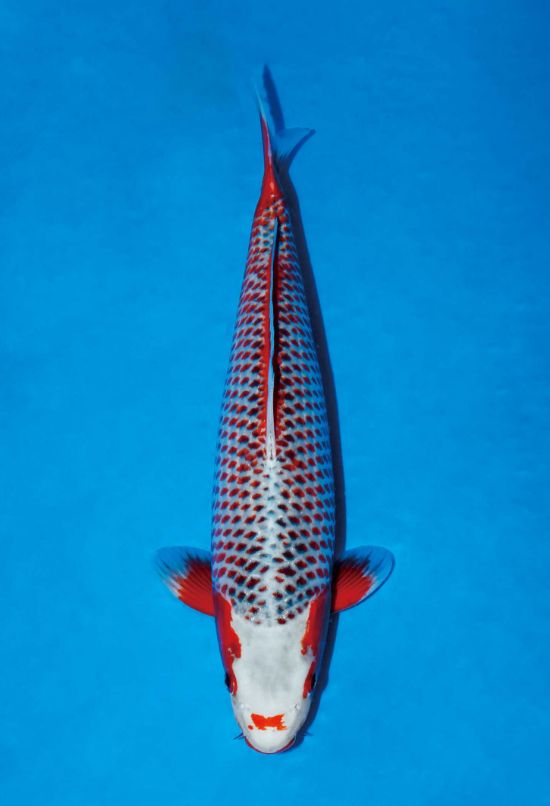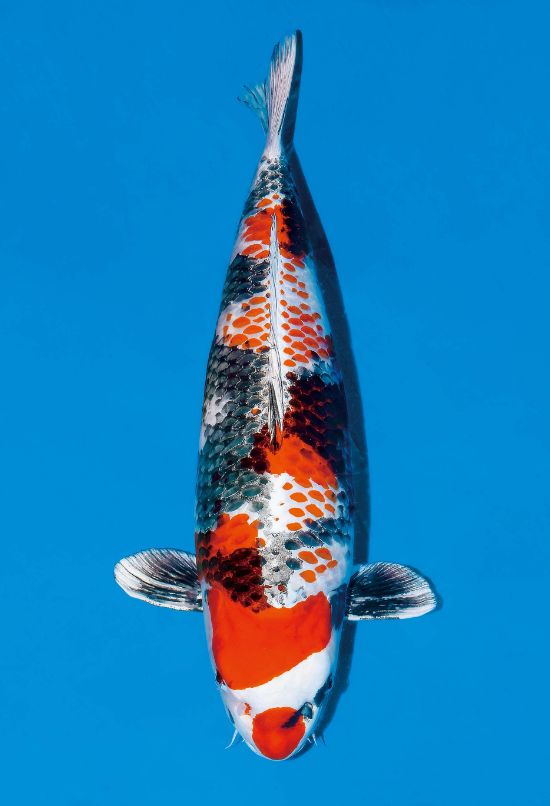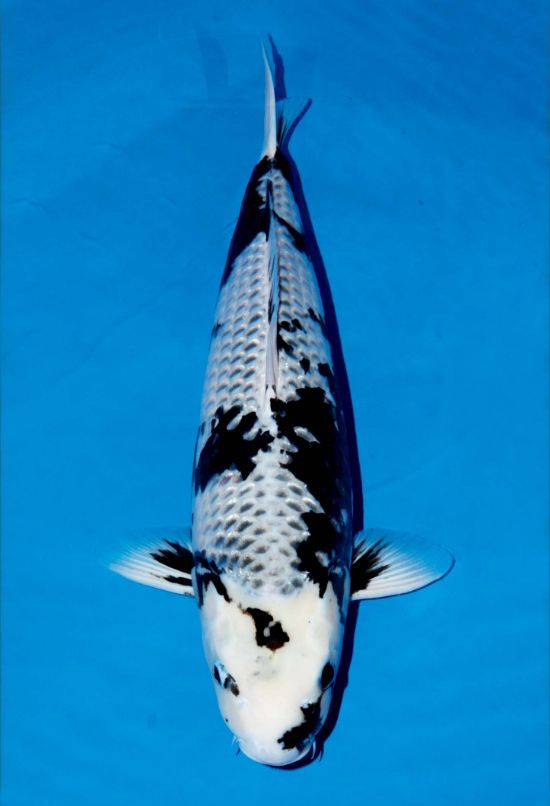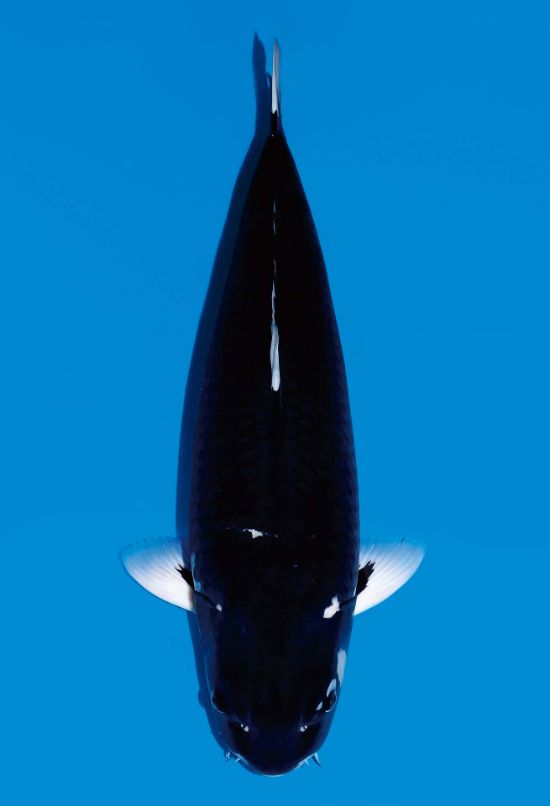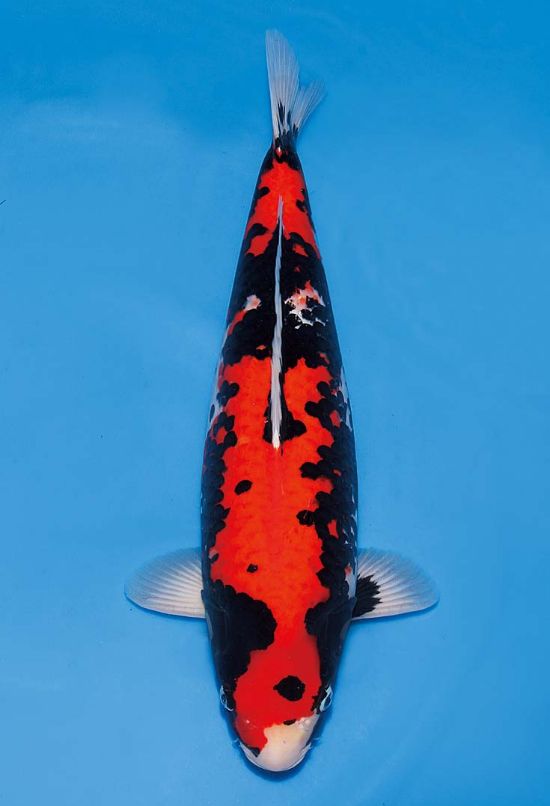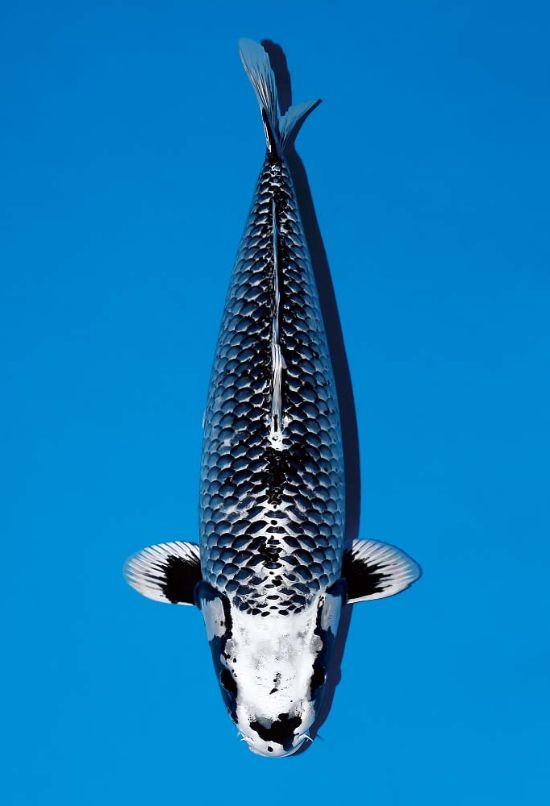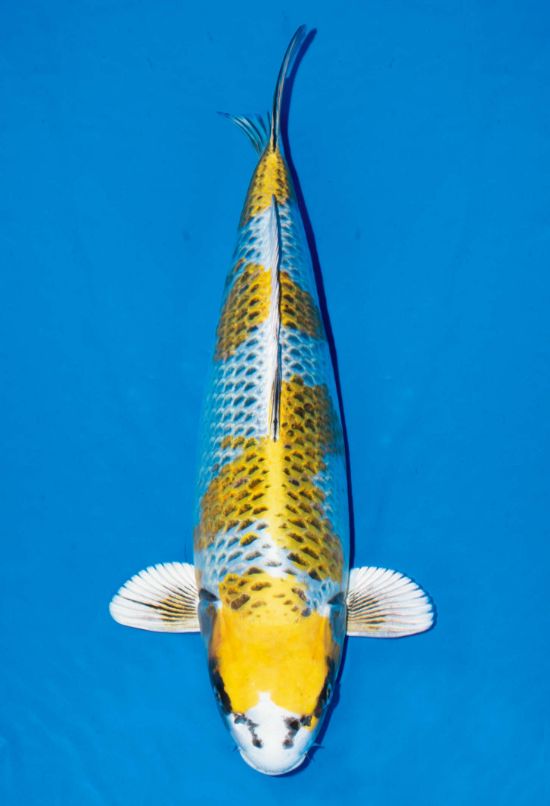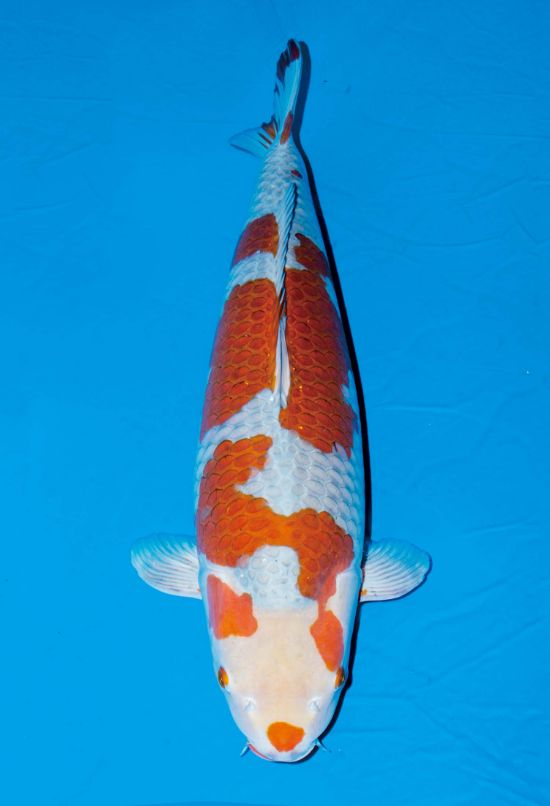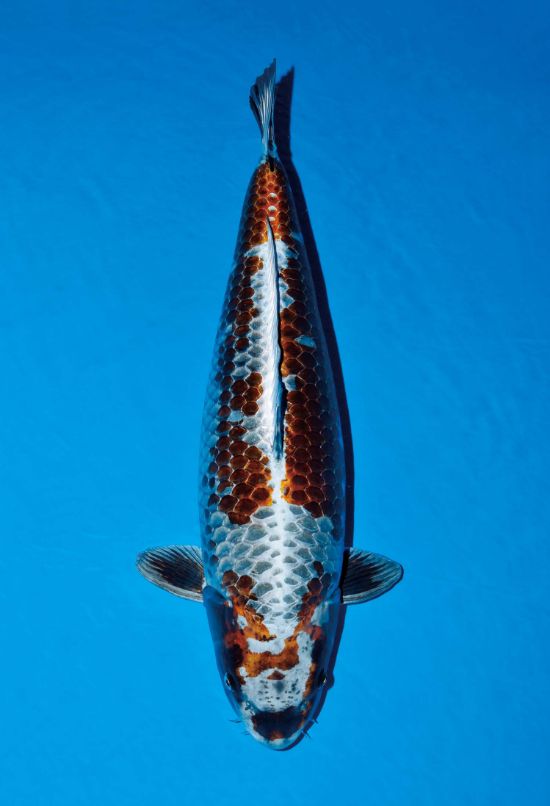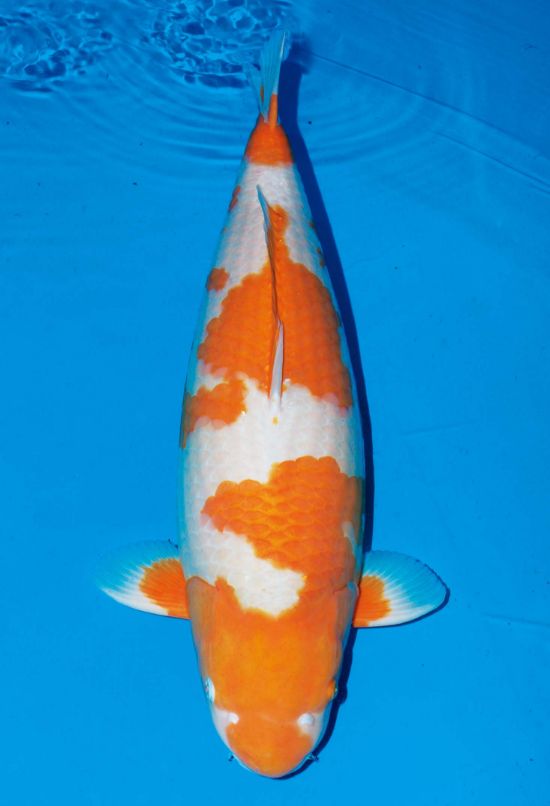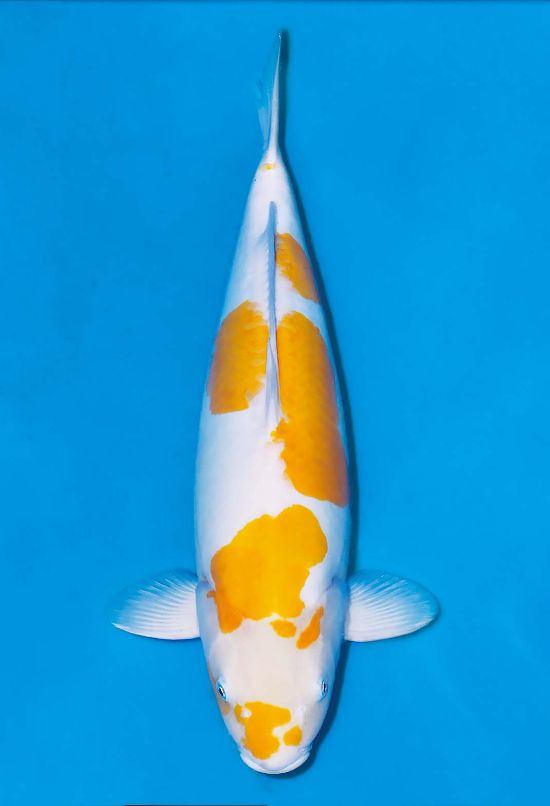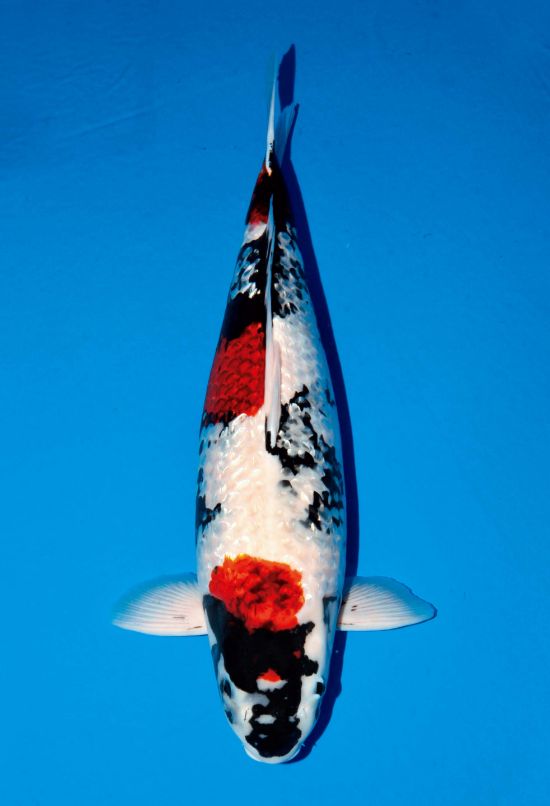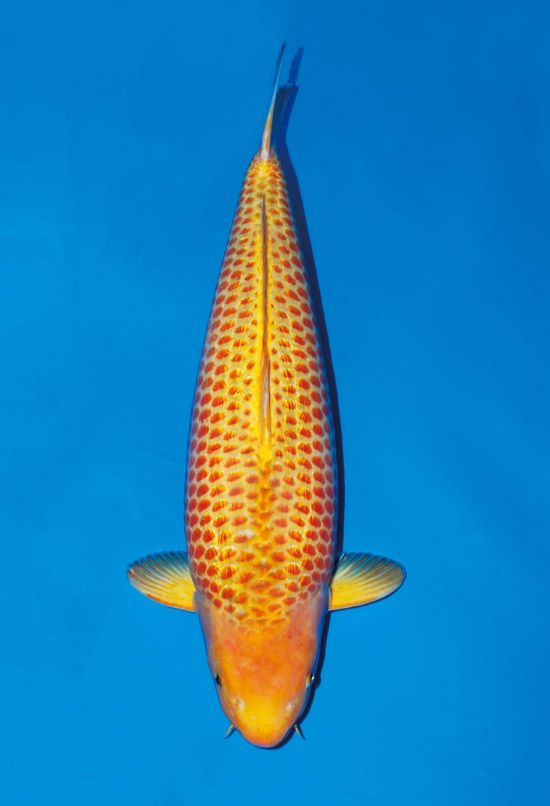Kawarigoi
It is said that there are more than 140 varieties of Nishikigoi with different colors and patterns, and Nishikigoi that do not belong to the 20 regulated varieties such as Kohaku and Taisho-sanshoku are collectively called Kawarigoi. The name Kawarigoi has two meanings. The first represents things that cannot be produced stably or that have appeared mutated, and the other represents things that can be produced stably and have conventional names. The latter includes cultivars such as Ochiha-shigure and Beni-kikokuryu, which are also popular at competitions.
- JAS No.2008 Kawarigoi
- Kawarigoi are not classified as Kohaku, Taisho-sanshoku, Showa-sanshoku, Shiroutsuri, Goshiki, A-ginrin, B-ginrin, Kujyaku Kumonryu, Doitsugoi, Hikari-moyo, Koromo, Tancho, Hikari-Utsuri, Hikari-muji, Shusui, Asagi, Bekko, Hiutsuri, Kiutsuri and Muji.
Kanoko-kohaku
Kanoko-kohaku has a white body, and part of the scales is dyed red and has a dotted pattern across the body. Some have scarlet imprints and some do not.
Kanoko-sanshoku
Kanoko-sanshoku has the appearance characteristics of Taisho-sansoku, with part of the scales dyed red and a dotted pattern across the body.
Kanoko-showa
Kanoko-showa has the appearance characteristics of Showa-sansoku, with part of the scales dyed red and a dotted pattern across the body.
Kanoko-asagi
Kanoko-asagi has the appearance characteristics of Asagi, with part of the scales dyed red and a dotted pattern across the body.
Kanoko-kin-showa
Kanoko-kin-showa has the appearance characteristics of Kanoko-showa, and the whole body shines brightly.
Goshiki-shigure
Goshiki-shigure has an "asagidi" pattern and yellow imprints across the body. It is gently glowing all over.
Kage-showa
Kage-showa has a black body, and there are scarlet and white imprints across the body. It has a mesh-like thin ink pattern in the scarlet and white imprints.
Kage-shiroutsuri
Kage-shiroutsuri has a black body, and there are white imprints across the body. It has a mesh-like ink pattern on white imprints and "utsuri-zumi" pattern.
Kage-hiutsuri
Kage-hiutsuri has a black body, and there are red scarlet imprints across the body. It has a mesh-like ink pattern on red scarlet imprints and "utsuri-zumi" pattern.
Kage-kiutsuri
Kage-kiutsuri has a black body, and there are yellow imprints across the body. It has a mesh-like ink pattern on yellow imprints and “utsuri-zumi” pattern.
Cha-utsuri
Cha-utsuri has a black body, and there are brown or reddish brown imprints across the body. It has a "utsuri-zumi" pattern.
Hajiro
Hajiro has white pectoral fins, and the whole body is jet black except for pectoral fins. In some individuals, part of the pectoral fin turns black.
Beni-matsukawa-bake
Beni-matsukawa-bake has scarlet patterns on the body, and the appearance characteristics of Matsukawa-bake.
Matsukawa-bake
Matsukawa-bake has white and jet black patterns across the body, and the whole body except for the head is covered with scales. Due to changes in the environment in which they live, the jet-black pattern may change frequently in a short period of time.
Ginga
Ginga has a white body and shiny scales all over the body It has an ”asagidi" pattern across the body.
Beni-ginga
Beni-ginga has a white body and shiny scales all over the body It has an ”asagidi" pattern and red imprints across the body.
Kirin
Kirin has golden imprints across the body, and the whole body is shining. In Kirin, part of the scales are dyed in light black, and the entire body has a mesh pattern.
Ochiba-shigure
Ochiba-shigure has a light pale yellow body, and there are earthenware color imprints across the body. It has a mesh-like pattern on the entire back due to the arrangement of scales.
Ochiba-utsuri
Ochiba-utsuri has a light pale yellow body, and there are earthenware color and black imprints across the body. It has a mesh-like pattern on the entire back due to the arrangement of scales.
Kogane-ochiba
The whole body of Kogane-ochiba shines brightly, and those having the appearance characteristics of Ochiba-shigure.
Metalic-doitsu-ochiba
Metalic-doitsu-ochiba has almost no scales, the skin is exposed, the whole body is shining, and it has the appearance characteristics of Ochiba-shigure. The entire back is shining silver.
Kikokuryu
Kikokuryu has its whole body shines, and those having the appearance characteristics of Kumonryu.
Beni-kikokuryu
Beni-kikokuryu has its whole body shines and scarlet imprints across the body. It has the appearance characteristics of Kikokuryu.
Kin-kikokuryu
Kin-kikokuryu has its whole body shines and golden imprints across the body. It has the appearance characteristics of Kikokuryu.
Kinsui
Kinsui has its whole body shines and the appearance characteristics of Shusui.
Kosui
Kosui has a white body and there are scarlet imprints on the abdomen as a general rule. It has almost no scales on the whole body and the skin is exposed.
Koyo
Koyo has a white background or a color close to white with yellow imprints across the body.
Midori-goi
Midori-goi has a yellow body with no imprints, and a olive-green back or green scales on the back.
Aya-wakaba
Aya-wakaba has almost no scales on the whole body and the skin is exposed. There are yellow imprints across the body, and the scales and the skin on the back are light black.
Kijiro
Kijiro has almost no scales on the whole body and the skin is exposed. There are lemon color imprints across the body. Some individuals has scales on the whole body.
Ginrin-koromo-showa
Ginrin-koromo-showa has shine golden or silver scales, and has the appearance characteristics of Koromo-showa.
Ginrin-kanoko-karashi
Ginrin-kanoko-karashi has shine golden or silver scales, and has mustard-colored body. It has a reddish dotted pattern on some of its scales. Some individuals have mustard-colored imprints and red dotted pattern on the body. It is commonly called to as "golden-corn" because of its external characteristics.




